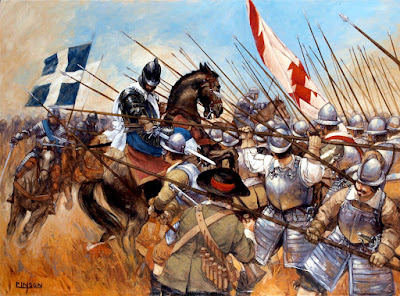“I
found the Ground rowling and moving under my Feet, upon which I said,
Lord, Sir, what’s this? Governor John White replied very composedly,
being a very grave Man, ‘it is an Earthquake, be not afraid, it will
soon be over’. But it increased, and we heard the Church and Tower fall;
upon which, we ran to save ourselves. I quickly lost him, and made
towards Morgan’s Fort, which being a wide open Place, I thought to be
there securest from the falling Houses: But as I made toward it, I saw
the Earth open and swallow-up a Multitude of People, and the Sea
mounting-in upon us over the Fortifications”-Reverend Emmanuel Heath, Rector of Saint Paul’s church, 1692.
 |
| Fate of Port Royal by Robert W. by Nicholson for National Geographic, February 1960 edition. |
English
Admiral William Penn had captured Jamaica from Spain in 1655. As an
attack from Cartagena was always possible, construction of Fort Cromwell
began to defend the harbor in 1656. By 1692 five forts defended the
port. A town was founded in the vicinity of the cay and the settlement
was soon populated by an array of sailors, merchants, craftsmen and
prostitutes. Originally called Point Cagway, it became Port Royal with
the Restoration of Charles II in 1660; at the same time Fort Cromwell
was renamed Fort Charles. From 1668, Royal Navy warships began to be
permanently stationed there in what became the Jamaica Station.
 |
| Henry Morgan enters Port Royal triumphantly in 1671 by William Gilkerson (1936-2015). |
Although
Port Royal was designed to serve as a defensive fortification guarding
the entrance to the harbor, it assumed much greater importance. Its well
positioned location within a well-protected harbor and its flat
topography surrounded by deep water close to shore, made it an ideal
place for loading, unloading and servicing of large ships. Ships'
captains, merchants, and craftsmen established themselves in Port Royal
to take advantage of of the trading and outfitting opportunities. As
Jamaica's economy grew and changed between 1655 and 1692, Port Royal
grew faster than any town founded by the English in the New World, and
it became the most economically important English port in the Americas.
In the early 1690s, Henry Morgan’s port city was home to 7,000-10,000
people, almost half directly involved with privateering.
 |
Contemporary engraving of the Port Royal's 1692 disaster
|
By
1692, the dense city, the largest and most affluent English town in the
Americas at this time, had 2,000 buildings, including brick buildings
of up to 4 storeys. At the time, Francis Hanson wrote that there was
more wealth per resident in Port Royal than in London!
Then,
it all came crashing down, literally: At 11:43 am on Saturday 7th of
June 1692, the hub of the British Caribbean was hit by a devastating
earthquake, causing 33 of the city’s 52 acres to sink straight down into
the liquefied substrate beneath the buildings in a matter of just 3
minutes. The town was hit by a tidal wave shortly after the earthquake
ended and many people who had been half buried by the quake were
drowned. The 32-gun, 5th rate HMS Swann was carried by the tsunami over
the top of many houses, before crashing on the roof of Lord Pike’s
mansion. She sank in middle of the ruins. In the 1980s, the shipwreck
was identified underwater at the ends of Lime and Queen Streets by the
Institute of Nautical Archaeology.
 |
Destruction of Port Royal by Andrew Howat
|
An
estimated 2,000 people were killed on that day, with 3,000 more dying
in the chaotic aftermath from injuries, the ensuing pillaging, hunger
and disease. What was left of Port Royal, once connected to the rest of
the island by a narrow strip of land, was now an island. The Palisadoes
cemetery, where Henry Morgan had been buried just 4 years before, was
one of the parts of the city to fall into the sea; his body has never
been subsequently located. Of the five forts that once protected the
island, only Fort Charles remained. The loss of Port Royal was a sudden,
catastrophic event that forever changed the English Caribbean.
 |
Port Royal before the 1692 earthquake by Peter Dunn
|































